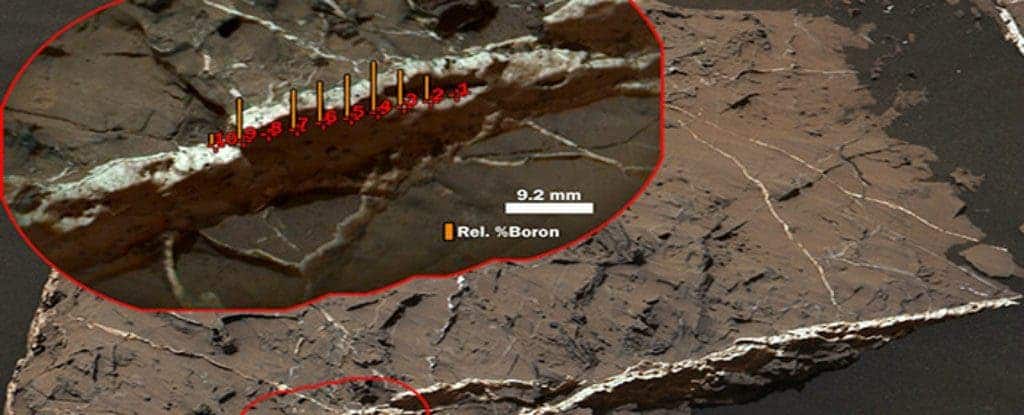The Curiosity Rover has found boron on the surface of Mars – a strong indication that the Red Planet once hosted long-term habitable groundwater, making it even more likely that life once existed on Mars.

ChemCam target Catabola is a raised resistant calcium sulfate vein with the highest abundance of boron observed so far. The red outline shows the location of the ChemCam target remote micro images (inset). The remote micro images show the location of each individual ChemCam laser point (red crosshairs) and the B chemistry associated with each point (colored bars). The scale bar is 9.2 mm or about 0.36 inches.
Credit: JPL-Caltech/MSSS/LANL/CNES-IRAP/William Rapin
The exciting discovery was announced at the American Geophysical Union conference. Because boron is associated with arid sites where much water has evaporated away, the perspectives are obviously intriguing.
“No prior mission to Mars has found boron,” said Patrick Gasda, a postdoctoral researcher at Los Alamos National Laboratory.
Here on Earth, similar traces can be found in California or other arid areas which were once rich in water. If this is also the case on Mars, then everything would align to make Mars suitable for extraterrestrial life.
“If the boron that we found in calcium sulfate mineral veins on Mars is similar to what we see on Earth, it would indicate that the groundwater of ancient Mars that formed these veins would have been 0-60 degrees Celsius [32-140 degrees Fahrenheit] and neutral-to-alkaline pH.” The temperature, pH, and dissolved mineral content of the groundwater could make it habitable.
The environmental implications of the boron and how exactly it came to be is still a matter of debate. It could be that the drying out of a lake resulted in a boron-containing deposit in an overlying layer, not yet reached by Curiosity. Some of the material from this layer could have later been carried by groundwater down into fractures in the rocks. Yet it could also be that the chemistry of clay-bearing deposits and groundwater affected how boron was picked up and dropped off within the local sediments. Either way, while there is still some debate going on, the evidence seems to indicate to a water-rich past, and one that could support life.
This type of active groundwater acts like a chemical reactor in a way. It dissolves old minerals, creates new ones, and generates a redistribution of electrons – all reactions which support the emergence of life. These dynamic processes are visible in the mineral veins that filled cracks in older layered rock. But this also affected the composition of that rock matrix surrounding the veins, and the fluid was in turn affected by the rock.
“There is so much variability in the composition at different elevations, we’ve hit a jackpot,” said John Grotzinger, of Caltech, Pasadena, Calif. As the rover gets further uphill, researchers are impressed by the complexity of the lake environments when clay-bearing sediments were being deposited and also by the complexity of the groundwater interactions after the sediments were buried.
The discovery of boron is just one of several exciting findings on Mars, but at the moment, we still don’t know for sure whether life did exist on Mars. The circumstantial evidence is strong, but at the end of the day, it’s still circumstantial evidence. But the stars are starting to align, and the future might hold some interesting things.









